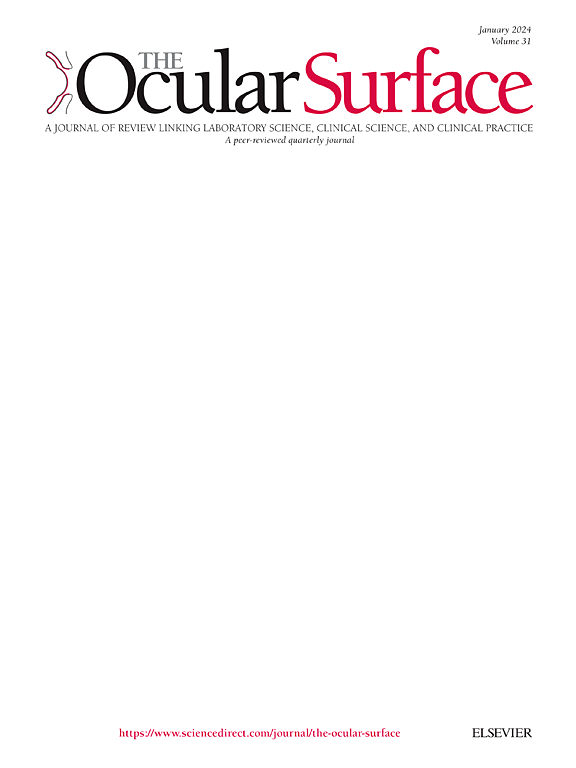Expert consensus on pediatric dry eye: Insights from a European Delphi study
IF 5.6
1区 医学
Q1 OPHTHALMOLOGY
引用次数: 0
Abstract
Context
Dry Eye Disease (DED) is a symptomatic multifactorial condition of the ocular surface, primarily characterized by tear film instability, which can lead to ocular surface damage. While traditionally associated with adults, recent studies have shown a significant prevalence of DED in pediatric populations, exacerbated by modern lifestyle changes such as increased screen time and environmental factors. Pediatric DED (PeDED) often goes underdiagnosed due to a lack of tailored diagnostic tools and the misattribution of symptoms to other conditions.
Methods
This Delphi study, conducted by a European panel of six ophthalmology experts sought to address expert consensus in pending challenges of PeDED.
Results
Over two rounds of surveys, 34 experts reached consensus on 39 of 46 statements, highlighting the need for age-specific diagnostic criteria and treatment protocols. The study identified environmental and lifestyle factors, such as screen time and ocular allergies, as significant risk factors for PeDED. There was strong consensus on the importance of adapting adult DED definitions and treatment approaches to better suit pediatric patients. The study also emphasized the cautious use of treatments like topical steroids or oral macrolides, especially in younger children.
Conclusion
The findings underscore the necessity for standardized clinical practices in diagnosing and managing PeDED, with a focus on improving the quality of life for affected children. Further research is required to validate these findings and develop comprehensive guidelines that cater to the unique needs of the pediatric population.
专家对儿童干眼症的共识:来自欧洲德尔菲研究的见解
干眼病(DED)是一种有症状的多因素眼表疾病,主要特征是泪膜不稳定,可导致眼表损伤。虽然传统上与成人有关,但最近的研究表明,儿童人群中DED的患病率很高,并且由于现代生活方式的改变(如屏幕时间增加和环境因素)而加剧。由于缺乏量身定制的诊断工具以及将症状错误地归因于其他疾病,儿科DED经常被误诊。该德尔菲研究由6名欧洲眼科专家组成的小组进行,旨在解决PeDED面临的挑战中的专家共识。结果在两轮调查中,34位专家对46项声明中的39项达成共识,强调了针对年龄的诊断标准和治疗方案的必要性。该研究确定了环境和生活方式因素,如屏幕时间和眼部过敏,是ed的重要风险因素。对于调整成人DED的定义和治疗方法以更好地适应儿科患者的重要性,人们达成了强烈的共识。该研究还强调了局部类固醇或口服大环内酯类药物等治疗方法的谨慎使用,特别是在年幼的儿童中。结论本研究结果强调了在诊断和管理PeDED时标准化临床实践的必要性,重点是提高患儿的生活质量。需要进一步的研究来验证这些发现,并制定全面的指导方针,以满足儿科人群的独特需求。
本文章由计算机程序翻译,如有差异,请以英文原文为准。
求助全文
约1分钟内获得全文
求助全文
来源期刊

Ocular Surface
医学-眼科学
CiteScore
11.60
自引率
14.10%
发文量
97
审稿时长
39 days
期刊介绍:
The Ocular Surface, a quarterly, a peer-reviewed journal, is an authoritative resource that integrates and interprets major findings in diverse fields related to the ocular surface, including ophthalmology, optometry, genetics, molecular biology, pharmacology, immunology, infectious disease, and epidemiology. Its critical review articles cover the most current knowledge on medical and surgical management of ocular surface pathology, new understandings of ocular surface physiology, the meaning of recent discoveries on how the ocular surface responds to injury and disease, and updates on drug and device development. The journal also publishes select original research reports and articles describing cutting-edge techniques and technology in the field.
Benefits to authors
We also provide many author benefits, such as free PDFs, a liberal copyright policy, special discounts on Elsevier publications and much more. Please click here for more information on our author services.
Please see our Guide for Authors for information on article submission. If you require any further information or help, please visit our Support Center
 求助内容:
求助内容: 应助结果提醒方式:
应助结果提醒方式:


